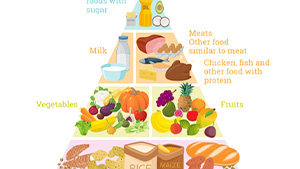MALNUTRITION
Malnutrition, in all its forms, includes undernutrition (the intake of inadequate vitamins or minerals) overweight, obesity and resulting diet-related non-communicable diseases (15). It can lead to reduced immunity, which can impair an individual’s ability to protect and recover from illness. At the same time, repeated infections can lead to malnutrition.
Malnutrition conditions
According to the World Health Organization (15), there are three broad groups:
- Undernutrition, which includes wasting (low weight-for-height), stunting (low height-for-age) and underweight (low weight-for-age). Undernutrition makes children in particular much more vulnerable to disease and death. The second National Nutrition Survey (2018) showed a marked improvement in the prevalence of stunting among children under five years in Tanzania. Between 2014-2018 chronic malnutrition or stunting was reduced from 34.7% to 31.8%. Despite this progress, it is estimated that more than 2.7 million children under the age of five were stunted in 2019 (40).
- Micronutrient-related malnutrition, which includes micronutrient deficiencies (a lack of important vitamins and minerals) or micronutrient excess; Iodine, vitamin A, and iron are the most important in global public health terms. In 2016, 57% of children under five were anaemic and 33% Vitamin A deficient) (41).
- Overweight, obesity diet-related non-communicable: this is caused by an imbalance between energy consumed (too much) and energy expended (too little). The World Health Organization states are that globally, people are consuming foods and drinks that are more energy-dense (high in sugars and fats) and engaging in less physical activity. In Tanzania, 31.7% of women (15-49 years) were found to be overweight and 11.5% were obese. In Zanzibar, the prevalence of overweight was over 40% (42).




